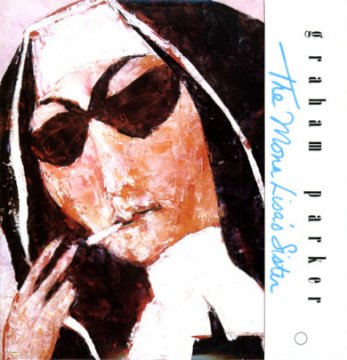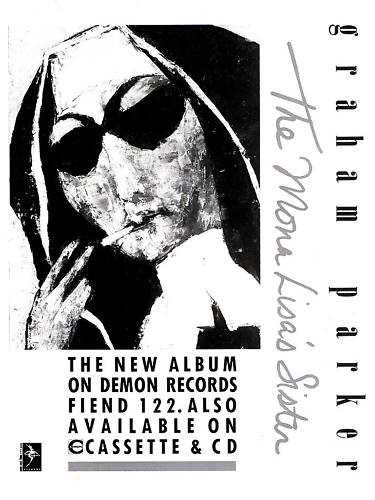
THE MONA LISA'S SISTER, RCA CD 8316-2-R, 5/1988, USA, & Demon FIENDCD 122, 7/1988, UK

THE MONA LISA'S SISTER, RCA CD 8316-2-R, 5/1988, USA, & Demon FIENDCD 122, 7/1988, UK |
|
DON'T LET IT BREAK YOU DOWN, UNDER THE MASK OF HAPPINESS, BACK IN TIME, I'M JUST YOUR MAN, OK HIERONYMOUS. GET STARTED. START A FIRE, THE GIRL ISN'T READY, BLUE HIGHWAYS, SUCCESS, I DON'T KNOW, CUPID. Produced by Graham Parker and Brinsley Schwarz, engineered by Jon Jacobs, assisted by Martin Edwards, recorded and mixed at 'Lansdowne Studios' London, mastered by Steve Rooke at 'Abbey Road Studios'. GP lead & backing vocals and acoustic guitars, Brinsley Schwarz electric guitars, backing vocals and percussion, Andrew Bodnar bass guitar, James Hallawell keyboards, Terry Williams drums. Drums on 'The Girl Isn't Ready' and 'I'm Just Your Man' by Pete Thomas, drums on 'Success' by Andy Duncan, backing vocals by Christie Chapman. Arranged by GP, BS, AB and Jed Lieber. Cover painting by Jack Drummond, photograph by Jolie Parker, cover concept by GP, sleeve design by Laurence Stevens. Thanks to Bob Buziak, Ralph Baker and Chandler Guitars. This has been a PARKER/SCHWARZ PRODUCTION. |
(GP's notes for the Buddha reissue)

THE RECORD COMPANY EXECUTIVE sheathed his impressive teeth behind a pair of alarmingly pink lips and crossed his arms with resigned elegance. The cuffs of his charcoal-grey Armani suit shimmered impeccably across a decal-free and business-like desk perched high in Atlantic Records' corporate eyrie in the pulsing throb of midtown Manhattan. He affixed me with a languescent eye, sighed, then looked for guidance from his German sidekick.
They always have a sidekick, I thought, despondently; a Mutt to their Jeff, a Laurel to their Hardy.
The sidekick had not enamored himself to me on our first meeting months before, after I had signed with the company, 'I thought your early stuff was good,' the rotter had opined with the tact of a sledgehammer. This was before I had presented, under the misconceived guidance of my manager, the demos of my brand new material. Those demos had now allegedly been scrutinized by this unlikely duo and, apparently, by other members of the Atlantic staff. They were not impressed.
A clueless Englishman who represented the UK A&R unit had likewise expressed ambivalence towards my new songs at a recent dinner in London. "You ought to write with David and David," he had suggested after a mere two glasses of red plonk. "Christ, I can just hear you singing that 'Welcome To The Boomtown’ number!" "Oh, yeah?" I countered. "What should we call ourselves then – 'David, Graham and David'?"
How I managed to resist the urge to smack the twerp upside the head I’ll never know.
Eventually I got mad. I got mad at my manager. I got mad at this label and its employees who could scarcely get through a sentence without expounding on the dubious successes of Phil Collins and White Lion and whatever else nonsense was stuffing the chart pages at that point in time; but most of all I got mad at myself for getting into this position in the first place. Rule Number One: Do not play your rough demos to the record company. With the overproduced bombast of the mid-eighties holding court, what possible chance was there that these people would understand a guy with an acoustic guitar and a couple of overdubs?
So what did I do? I went off and wrote another dozen songs. Just to spite them.
These tunes would eventually become The Mona Lisa's Sister, but Atlantic heard them and thought they were no better than the other twenty songs they had already rejected! Plus, it must be said, when I informed the aforementioned RECORD COMPANY EXECUTIVE that I thought the age of the monster snare drum sound was surely coming to an end and that drums and "crack rhythm sections" (he kept going on about those in depressingly knee-jerk fashion) were not important anyway, and that I should produce this album myself making only the singer, the song, and the acoustic guitar the focal point well ... this went right over the old fellow's head! It transpired that my outlandish idea of not attempting to make a record that sounded like everybody else's got me thrown off the label, and I swiftly outlined a proposal for my next record deal: "Give me the advance and I'll go and make an album and you don't hear a thing until it's finished," was my opening gambit! Sensibly, RCA/BMG went for it like Jack Russell down a badger sel and within weeks I was scooting around London with co-producer Brinsley Schwarz and engineer Jon Jacobs until we finally stumbled into Lansdowne Studio, Bayswater, where Squeezing Out Sparks had been made 10 years earlier.
The place had not changed since 1978. Buried in the bowels of a nondescript building, the studio was still used more frequently by TV personalities and advertisers cutting jingles than rock ‘n rollers. But I'd been running on gut feelings since the Atlantic debacle and despite misgivings from my cohorts, I insisted that this was the place to record something different. I needed a sound stripped of superfluous information, devoid of artifice, and free from the stamp of a "Producer." I would cut the songs with merely an acoustic guitar and a drum kit and, most importantly, capture the vocal live. None of that going back to record vocal tracks two months later only to find something utterly artificial and fossilized blasting through the headset. This would he pure and real, like the songs. The bass, keyboards and lead guitar were added as the mood struck, and with these instruments caressing the skeletal tracks, I developed the war cry that would set the standard of the accompaniment and forge the sensibilities of the record: "Sonic Detail," I bellowed like a madman! Sonic detail, not supersonic sludge, which I thought my recent records had been buried under. Funnily enough, I bumped into two engineer/producers not long after the album had been released and they seemed confused by its popularity and good reviews. One thought it sounded "unfinished," and the other one decided that there was something just plain wrong with it!
I knew then that I had attained Success.
GP
Back to GP album discography